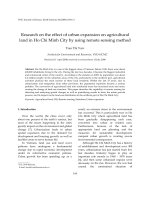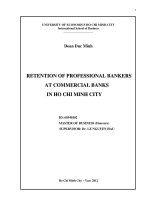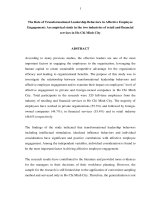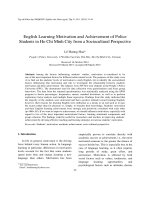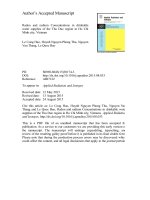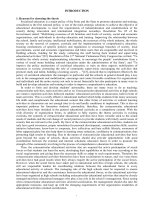RETENTION OF PROFESSIONAL BANKERS AT COMMERCIAL BANKS IN HO CHI MINH CITY
Bạn đang xem bản rút gọn của tài liệu. Xem và tải ngay bản đầy đủ của tài liệu tại đây (452.02 KB, 64 trang )
1
UNIVERSITY OF ECONOMICS HO CHI MINH CITY
International School of Business
Doan Duc Minh
R
R
E
E
T
T
E
E
N
N
T
T
I
I
O
O
N
N
O
O
F
F
P
P
R
R
O
O
F
F
E
E
S
S
S
S
I
I
O
O
N
N
A
A
L
L
B
B
A
A
N
N
K
K
E
E
R
R
S
S
A
A
T
T
C
C
O
O
M
M
M
M
E
E
R
R
C
C
I
I
A
A
L
L
B
B
A
A
N
N
K
K
S
S
I
I
N
N
H
H
O
O
C
C
H
H
I
I
M
M
I
I
N
N
H
H
C
C
I
I
T
T
Y
Y
ID: 60340102
MASTER OF BUSINESS (Honours)
SUPERVISOR: Dr. LE NGUYEN HAU
Ho Chi Minh City – Year 2012
RETENTION OF PROFESSIONAL BANKERS i
ACKNOWLEDGEMENTS
Beginning of my thesis, I would like to express all my sincere thanks to those
people who made this thesis possible and an unforgettable experience for me.
First of all, I would like to show my deepest sense to my supervisor Dr. Le
Nguyen Hau, who offered his continuous advice and encouragement throughout
the course of this thesis. Dr. Hau has offered me the systematic guidance and
great inspiration in putting into me toward the scientific field.
Then, I am thankful to all my colleagues and Board of Management in Shinhan
Bank Vietnam, United Overseas Bank, Hong Leong Bank, Vietnam Commercial
Bank, Asia Commercial Bank, Saigon Commercial Bank, Dong A Commercial
Bank for the consultation, orientation and support during my research process.
Last but not least, this is a great time for a son of family, husband of wife to take
this opportunity to express the profound gratitude from my deep heart to my
beloved family for their love and continuous support both spiritually and
materially.
RETENTION OF PROFESSIONAL BANKERS ii
ABSTRACT
Employees retaining is an important goal of every corporate organization, which
drives company to hit the target. This thesis explores the factors that can
significantly impact employee retention in an organization, and specializes in
field of commercial banks in Ho Chi Minh City. It attempts to relate some of the
factors discovered to major theories in employee retention. The literature
surveyed by this study mention employee motivation and job satisfaction as the
main factors that influence employee retention rates. This survey implies that still
significant for managing employee retention in today’s rapidly expanding
banking industry.
Human resources is definitely one of the most valuable assets in the
organizations, however, high turnover is currently being mentioned recently.
There are a lot of researches around this topic because retaining employees were
realized to be very costly to the organizations. Therefore, retention of key
personnel is a precedent issue for all banks and it seems not many research
reports conducted in Vietnam banking industry.
In the labor market, competitors are always attracting key personnel who are
valued core and not satisfied with their current job. This research explores the
current situation of job satisfaction of key personnel and figures out the
antecedent factors, which impacts job satisfaction. Finally, managerial
implications are withdrawn for improving the level of satisfactions, retaining key
personnel.
Employing a quantitative approach, in which, the data were collected from 160
professional bankers (“bankers”) in commercial banks in Ho Chi Minh City,
multiple regression analysis has resulted in the determinants of job satisfaction,
and a significant impact of job satisfaction on job satisfaction. Pay and leadership
support are found to be two most important factors, other factors include benefit,
opportunities of training and promotion, work challenges. The analysis results
RETENTION OF PROFESSIONAL BANKERS iii
also show that bankers in selected commercial banks are currently not completely
satisfied with their jobs. Based on the statistical results, managerial implications
have been discussed and recommendations are provided to improve the retention
rate of the banking industry in Ho Chi Minh City.
RETENTION OF PROFESSIONAL BANKERS iv
TABLE OF CONTENTS
ACKNOWLEDGEMENTS i
ABSTRACT ii
TABLE OF CONTENTS iv
LIST OF TABLES vi
LIST OF FIGURES vii
CHAPTER 1: INTRODUCTION…………………………………….………… 1
1.1Background…………………………………………………….….… …1
1.2 Problem statements……………………………………………… ….… 2
1.3 Research objectives……………………………………………….…… 3
1.4 Scope of study…………………………………………………….…… 3
1.5 Thesis structure…………………………………………….…….….……3
CHAPTER 2: LITERATUE REVIEW………………………………….….…… 4
2.1 Maslow’s hierarchy of needs…………………………………… ………4
2.2 Retention………………………………………………………….…… 5
2.3 Job satisfaction and antecedent factors………………………… …… 7
2.4 Moderating factors……………………………………………… …….12
2.5 Research model ……………………………………………….……… 13
2.6 Summary of hypotheses…………………….………………… … … 13
CHAPTER 3: RESEARCH METHOD…………………………….……….……15
3.1 Research procedure…………………………………………….….……15
3.2 Measurement scales……………………………………………….……15
3.3 Method of data collection…………………………………………… 19
3.4 Method of analysis…………………………………………….…….….19
3.4.1 Assessment of measurement of scale……………………….….…20
3.4.2 Multiple regression………………………………………….… …21
CHAPTER 4: RESEARCH RESULT……………………………………… 22
4.1 Introduction……………………… ……………………………………22
4.2 Sample characteristics…………………………… ……………………22
4.3 Assessment of measurement of scales…………….……….……….… 23
RETENTION OF PROFESSIONAL BANKERS v
4.3.1 EFA for individual scales of antecedent factors…………….……23
4.3.2 EFA for all scales together of antecedent factors……….……… 26
4.3.3 Assessment for job satisfaction……………………………….… 29
4.4 Assessment of theoretical model and hypotheses……………….…… 30
4.4.1 Assessment of theoretical model………………………….…… 30
4.4.2 Assessment level of overall job satisfaction………………….… 32
4.4.3 Assessment of influences of organization/ employee
characteristics to impact of antecedent factors on job satisfaction…… 33
4.4.4 Test of hypotheses…………………………………………… … 35
4.5 Discussion………………………………………………………….… 39
4.6 Managerial implications…………………………………………… ….40
CHAPTER 5: CONCLUSION AND RECOMMENDATIONS……….……… 46
5.1 Conclusion……………………………………………………….…… 46
5.2 Recommendations……………………………………………… …… 46
5.3 Limitation and further research directions………………………….….48
REFERENCES…………………………………………………….…… ……viii
QUESTIONAIRRES………………………………………………….….………xii
RETENTION OF PROFESSIONAL BANKERS vi
LIST OF TABLES
Table 2.1: Maslow‘s hierarchy of needs 5
Table 3.1: Summary of scales for 8 constructs in the model 17
Table 4.1: Sample characteristics 21
Table 4.2: EFA and reliability test result for scales 23
Table 4.3: EFA and reliability test result for three scales refined 25
Table 4.4: Result of joint factors analysis for 7 scales 27
Table 4.5: Characteristics of 7 scales for re-assessment of reliability 28
Table 4.6: Assessment for job satisfaction scale 28
Table 4.7: Multiple regression result of antecedent factors to job satisfaction 29
Table 4.8: R square value 29
Table 4.9: F and Sig. value 30
Table 4.10: Regression result between job satisfaction and retention 30
Table 4.11: R square value 30
Table 4.12: F and Sig. value 30
Table 4.13: Means values of different factors 31
Table 4.14: Differences of impact of antecedent factors by gender 32
Table 4.15: Differences of impact of antecedent factors by age 33
Table 4.16: Differences of impact of antecedent factors by ownership 33
Table 4.17: Differences of impact of antecedent factors by size 34
Table 4.18: Regression coefficients 35
RETENTION OF PROFESSIONAL BANKERS vii
LIST OF FIGURES
Figure 2.1: The research model 13
Figure 3.1: Research procedure 15
Figure 4.1: Regression coefficients model 38
RETENTION OF PROFESSIONAL BANKERS 1
CHAPTER 1
INTRODUCTION
This chapter is an introduction and intended to provide background information
on the nature of the present study and its objectives and purpose. It is divided into
four sections. The first section presents background of the research, the second
part presents the problem statement, the third part presents the objective, and the
final section presents the scope of study.
1.1 Background
The retention of bankers has been shown to be significant to the development and
the accomplishment of the organization’s goals and objectives. In recent years,
the system of financial institutions and banks in Vietnam has been developed in
increasing quantity of credit institutions and quality in diversity of ownership and
banking services. Currently, the whole banking system has reached at number of
52 local commercial banks, 51 foreign bank branches, 31 of non-bank credit
institutions. As the "blood" of the economy, the banking sector has been grown
remarkable and contributed to the stable development of Vietnam.
The local commercial banks in Ho Chi Minh City (the banks) were established
along with the development process of Vietnam economy. In the first years of
development, the banks have developed gradually, with small and medium scale,
and not really pay attention to human resource management (HRM). Due to the
development of economy, the banks have boomed and developed remarkably.
Especially in 5 years recently, the banks has set up with the wide network
branches and the number of bankers in this industry increased by more than
20,000 bankers, growth of the average number of bankers more than 15% per
year. Along to the stable development, HRM requires improvement and upgrade
to professional level. However, HRM practices in the banks have not been
focused and still applied the old-fashion method. Board of management faced the
serious issue that employee turnover increased about 9.5% per year within recent
RETENTION OF PROFESSIONAL BANKERS 2
three years (Asia Banker Forum, 2011). The banks has been conducting a
campaign to reform human resources management system to improve the
effectiveness of HRM, high labor productivity, raise incomes and policies to
retain bankers.
The banks also do understand that the professional bankers are the key factor in
competition in the banking market and this may cause a threat to the success of
long-term businesses. For this reason, the banks rose up a query how to retain
professional staff and satisfy their work-related needs would help.
1.2 Problem statements
Board of management of the banks are aware of the critical role of talent
workforce and striving to attract and retain their bankers by various measures
such as increasing salary and allowance, conducting intensive training courses,
offering more opportunities for career promotion and incentive abroad trips for
high performance bankers. However, the high turnover rate still exceeds their
expectations in spite of bank efforts. Why is turnover still high after those
efforts? What are bankers’ demands? How much percent are the bankers satisfied
with their current job? Is there relationship between job satisfaction and
employee retention?
Literature on human resource management provides some general hints in coping
with this managerial problem of employee retention (e.g. Maslow, 1943, 1954;
Bame, 1993; Becker & Gerhart, 1996; Hom & Griffieth, 1995). Nevertheless, the
right solution under the current social-economic context, organization leaders
need to understand in more details as higher salary, promotion opportunities, and
related other factors as motivation, recognition, working environment, good
relationships with the manager and colleagues, corporate culture. What are the
affected important factors?
Due to answer these questions, management board not only has an insight into
the issue of HRM in Vietnam, but also provides specific formation for managers
in the fields to solve the problem of retaining their talent bankers.
RETENTION OF PROFESSIONAL BANKERS 3
1.3 Research objectives
In response to the above stated problems, this research is conducted with below
aims:
Determine quantitatively antecedent factors and their relative contributions to
the overall satisfaction of bankers in the local commercial banks.
Estimate the impact of job satisfaction on the retention (intent to stay) of
bankers in the field.
1.4 Scope of study
Given the limited resources and time, the empirical data for the research were
collected from the commercial banks in Ho Chi Minh City.
Examinees on this study include senior-officers, supervisors and managers and
who achieved bachelor, master degree and higher degree.
Only work – related factors will be investigated in this study. Other possible
factors (e.g. social or cultural factor) are beyond the scope of this study.
1.5 Thesis structure
This thesis is organized as follows:
Chapter 1 presents the research background, problem statements, research
objectives, scope of study and thesis structure.
Chapter 2 introduces research model and its hypotheses as well as its literature
review.
Chapter 3 illustrates the methodology conducted in this paper.
Chapter 4 presents research results is based on data collected.
Chapter 5 summarizes the research results, provide the findings and
recommendations.
RETENTION OF PROFESSIONAL BANKERS 4
CHAPTER 2
LITERATURE REVIEW
The literature clearly indicated that there are seven keys to employee retention.
They are work challenge, training and promotion opportunity, leadership support,
colleague relationship, salary, benefits, working environment. The model of job
satisfaction and retention will be proposed for this specific study, which provides
a basis for the development of hypotheses. Over the years, many studies relating
to personnel in terms of human needs, job satisfaction, organizational
commitments and retention have been conducted. In this literature review,
Maslow hierarchy of needs, retention, job satisfaction and its antecedent factors
will be presented. Then, the model of job satisfaction and retention will be
proposed for this specific study, which provides a basis for the development of
hypotheses.
2.1 Maslow’s hierarchy of needs
One of the earliest and best-known theories of individual motivation, which is
applicable to the current study, is Maslow’s hierarchy of needs (Table 2.1).
Maslow advocates that within every human being lies a hierarchy of needs.
These needs are:
Physiological needs: related to essential factors to survival, such as food, water,
and shelter. In organization, these needs are mainly presented as monthly salary.
Safety needs: related to security, safety in workplace and life. At this level, the
individual strives to look for or form the safe environment from external dangers.
In organization, these needs are presented via hygiene factors, long-term
contribution, social and medical insurance policies…
Social needs: related to relationship with people, being member of teamwork,
being loved. In organization, these needs are identified by colleague relationship,
leader relationship….
RETENTION OF PROFESSIONAL BANKERS 5
Esteem: the drives for feelings of self-worth and individual importance, need of
respect in workplace and daily life are took place at this level. Organizations
often pay incentives through rewards, bonus, promotions…
Self-actualization: at the top of the hierarchy, the motivator is a sense of
fulfillment that allows individual to maximize their own growth and contribute.
In organization, these needs are satisfied by opportunities of training,
development and innovation.
Once each of these needs is satisfied, the individual moves up to the higher level
of the hierarchy.
Table 2.1: Maslow’s hierarchy of needs
Source: Mendenhall et al., (1995)
2.2 Retention
Over the past decade, the way in which people were managed and developed at
work has come to be recognized as one of the primary factors in achieving
improvement in organizational performance (BQF, 1998; Marchington and
Wilkinson, 1997; Phillips, 1997). This aspect was reflected by popular idioms
such as ‘people are our most important asset’ (Accenture, 2001). From the review
of extant literature, it was acknowledged that the employees of successful
Implemented
Out Of The Field
Need
Implemented
In The Field
Education, religion,
habit, individual
development
Self-actualization
Opportunities of training,
promotion, creativity,
development
Acceptance of family,
friend, community
Esteem
Recognition, high
position, increasing
responsibility
Family, friend,
community
Being loved, being
member of team
Team working,
colleague, supervisor,
customer
Un-fear about war,
pollution, conflict
Safety
Safety of working, long
term job, benefit
Food, water, sexuality
Physiology
Basic wage, temperature,
air
RETENTION OF PROFESSIONAL BANKERS 6
organizations were shared a fundamental philosophy of valuing and investing
(Anand, 1997; Maguire, 1995). In fact, several studies have described human
resource management as a means of achieving competitive advantage (Delery,
1998; Walker, 2001). Consistent with this perspective, the retention of their
critical (core) employees is an equally important issue for organizations.
Retention is about developing strategies that reduce the number of people who
leave the organization for avoidable reasons. Organizations need to retain
employees with the required balance of skills and experience to ensure that
business can be maintained (Stucberry, 2003). Solutions to retain employees are
really not simple. There are many factors that affect the employee's reasons for
staying with the organizations, as well as how important those factors are to
employees. In order to retain employees, the organization must understand these
factors, which drives people to perform their jobs and monitor the job satisfaction
of bankers.
Most organizations today continue to struggle with retention hardly because they
are only relying on salary increases and bonuses to prevent turnover (Accenture,
2001; Gumbus and Johnson, 2003). Managing core employees effectively means
identifying their needs. Employees bring their needs, aspirations, and hopes to
their jobs and working environment where their abilities can be utilized and their
basic needs can be satisfied.
At the centre of some turnover models have been variables of job satisfaction and
organizational commitment (Steele, 2002) but tendency were mainly developed
from the vast amount of researches on job satisfaction (Porters and Steers, 1973).
In this research, job satisfaction is considered as antecedents as they have strong
direct influence to retention. Job satisfaction is a subjective emotional evaluation
made consciously or unconsciously by the employee and is defined as a
pleasurable or positive emotional state resulting from the appraisal of one’s job
or job experiences (Locke, 1976). Job satisfaction is multidimensional in nature
with specific facets including satisfaction with work, salary, promotion,
colleague (Rice, Gentile and McFarlin, 1991). Work is such a large part of an
employee’s life and is represented by a belief that organizations who are more
satisfied with their work experiences and environment will stay longer (Spector,
RETENTION OF PROFESSIONAL BANKERS 7
2000), will attend work regularly, and perform at an optimum level (Porters and
Steers, 1973). Job satisfaction is included in this research because many
researchers have shown that the level of job satisfaction is positively related to
retention (Koslowsky, 1991; Hom and Griffeth, 1991). Therefore, employees
who are satisfied with their job are more likely to stay in their organizations.
From the above, we could hypothesize that:
H1: There is a positive impact of job satisfaction on the retention of bankers.
2.3 Job satisfaction and antecedent factors
Job satisfaction is an employee's general positive attitude toward the job (Byars
and Rue, 2000). It is a commonly defined as the extent to which bankers like
their work (Agho et al., 1993). It is also an attitude based on employee's negative
or positive perception of their jobs or work environments (Reilly et al., 1991), the
degree to which there is a good fit between the individual and the organization
(Ivancevich et al., 1997). Simply stated, the more people's work environment
meet their needs including intrinsic and extrinsic needs (Abraham Maslow,1954),
values, or personal characteristics, the greater the degree of job satisfaction
(Ellickson, 2002) will be.
Recent studies have identified that job satisfaction of employees is defined and
measured in two aspects: overall satisfaction of job and satisfaction of job
components. Job satisfaction is one criterion for establishing the health of an
organization and overall satisfaction is a function of a combination of situational
characteristics and situational occurrences and it is also presented emotions
covered all aspects of work. Smith et al. (1996) developed a scale to measure job
satisfaction (JDI-index). It was also used in more than 600 researches among 20
years, however, JDI also had defects. Some of researches, which are even in
Western development countries, criticized that it was complex, imperfect
(Buffum and Konick, 1982). Some researchers had modified the scale to fit
specific contexts (Crossman and Bassem, 2003; Tr
ần T
h
ị
Kim Dung, 2005).
Considering the above, seven factors are proposed in this study as antecedents of
job satisfaction. They are: work challenge, training and promotion opportunities,
leadership support, colleague relationship, salary, benefit, work environment.
RETENTION OF PROFESSIONAL BANKERS 8
Additionally, organizational and individual characteristics are included into the
model as moderating factors (age, gender, organization ownership and
organization size).
Work challenge: related to work nature, chances to use personal skills and
capacities, exciting feeling in work. Employees need to be stimulated with
creative challenges or they will go where the excitement is. It is very important to
provide employees challenging assignments with well-defined performance
measures and feedback on the high performance environment because of that,
they can achieve their personal objectives (Furnham, 2002) and reaching job
satisfaction. The necessity of mastering new skills keeps employees satisfied and
innovative (Ferguson, 1990; Walker, 2001). Employees want a job with broad
duties and a lot of variety tasks. In part, it is because they want to have more job
skills on their resume when they are forced to get another job (Jardine and Amig,
2001). Organizations which did not give employees with challenging and
interesting work, freedom to be creative, opportunities to develop new skills,
were usually received express negativity and lack of loyalty from their
employees. In such organization, employees are more likely to report negative
feelings and attitudes toward the organization, lower levels of commitment, and
greater intentions to leave the organization (Phillips, 1997). Thus, the hypothesis
is:
H2. There is a positive impact of work challenge on job satisfaction.
Training and promotion opportunity: related to employees’ perception to
opportunities of training, personal capacities development, promotion. Training
is considered a form of human capital investment whether that investment is
made by the individual or by the firm (Goldstein, 1991; Wetland, 2003). Training
programs enhance employee job skills when they are employed. Employees are
expected to acquire new skills and knowledge, apply to the current job, and share
them with other employees (Noe, 1999). Employees who participate in training
course will be provided specific skills or correct deficiencies in their
performances, while development is only an effort to provide employee abilities
which the organization will need in the future (Gomez-Mejia, Balkin and Cardy,
RETENTION OF PROFESSIONAL BANKERS 9
1995). Skill development could include improving basic literacy, technological
know-how, interpersonal communication, or problem solving abilities. According
to Storey and Sisson (1993), training and promotion is a symbol of the
employer’s commitment to staff. Training and promotion can also serve to lower
turnover (Frazis et al., 1998; Wetland, 2003). It is also reflective of an
organizational strategy based on adding value rather then lowering cost. Leading
companies have acknowledged that providing employees with a comprehensive
range of career and skills development opportunities is the key to attract and
retain the kind of flexibility, technologically sophisticated workforce that
companies need to succeed in the digital economy (Accenture, 2001; Bassi and
Van Buren, 1999).Thus, the hypothesis is:
H3: There is a positive impact of the training and promotion opportunities on
job satisfaction.
Leadership support: related to relationship between employees and leaders,
support of leader, behavior of leader, and leader’s skill on management. There
are many leadership definitions of researchers such as: leadership is
conceptualized in terms of four tasks that need to be accomplished in any
organization: providing orientation, assuring alignment, building commitment
and facing adaptive challenges (Risher and Stopper, 2002). Leaders are central to
the process of creating cultures, systems, and structures that foster knowledge
creation, sharing, and cultivation (Bryant, 2003). The impact of leaders have
been examined by numerous leadership studies in a wide variety of
organizations, and results show that leadership styles in a high-level of follower
motivation and commitment as well as well-above-average organizational
performance (Bryman, 1992; Elby et al., 1999; Podsakoff and Steyrer, 1998).
Several researchers have thought highly of the positive influence of leaders in
organizational outcomes, which resulted in lowered intention to leave and
increased organizational behavior (Alimo-Metcalfe and Alban-Metcalfe, 2001;
Pillai, Shreissheim and Williams, 1999; Yammariono and Bass, 1990), leading to
stronger organizational commitment, higher intention to stay of employees
RETENTION OF PROFESSIONAL BANKERS 10
(Alimo-Metcalfe and Alban-Metcalfe, 2001; Podsakoff et al., 1996). Therefore,
based on the literature review, the hypothesis is:
H4: There is a positive impact of leadership support on job satisfaction.
Colleague relationship: related to behavior, relation to colleagues at work and
teamwork. It is defined as the behavior of an individual that results in unforced
influence when that person is directing and coordinating the activities of a group
toward the accomplishment of a common goal (Bryman, 1992). Colleague’s
supportiveness refers to the friendliness and the extent to which colleagues pay
attention to comments and concerns (Campion et al., 1993; Hart et al., 2003).
Interactions with colleagues may serve an affective psychological function by
providing emotional support against the stresses of the organization’s
socialization initiatives and uncertainties of the work setting (Jablin, 1987).
Employees stay when they have strong relationships with their work colleagues
(Clarke, 2001). Organizations today encourage team building, project
assignments involving work with colleagues, and opportunities for social
interaction both inside and outside the job (Marchington, 2000). Fundamentally,
employees who work as a team are more likely to feel an increased commitment
to the work unit's efforts and the organization as a whole (Cohen and Bailey,
1997; Meyer and Allen, 1997). Consequently, employees tend to remain in
organizations due to the strong teamwork relationship they have established at
the workplace (Clark, 2001; Marchington, 2000). Therefore, it is posited that:
H5: There is a positive impact of colleague relationship on job satisfaction.
Salary: related to employee’s perception on fairness of pay. Salary is related to
job satisfaction. Most managers believe that salary is the prior retention factor
and many employees leave the organization by better pay or higher compensation
(Mathis and Jackson, 2003). Salary continues to be important in determining
motivation to perform (McCallum, 1998). Past motivational theories such as
expectancy and equity theories have predicted variations in motivation because
of varying valences of outcomes as pay (Das, 2002). However, in practice, salary
is treated as just one of the outcomes and often measured with little precision
RETENTION OF PROFESSIONAL BANKERS 11
(Mitchell and Mickel, 1999). A fair salary is the cornerstone of the contractual
and implied agreements between employees and employers, the underlying
assumption being that money can influence behavior (Parker and Wright, 2001).
Psychological theory states that the importance of fairness is a basic need for the
well being and satisfaction of employees (Blau, 1989). Therefore, employees
who perceive that they are being treated fairness in pay are more likely to have a
high degree of satisfaction and continue their employment with the organization.
This research tests the hypothesis that:
H6: There is a positive impact of salary on job satisfaction.
Benefits: employee benefits, sometimes called Fringe benefits (medical
insurance, healthcare policy, accidence insurance…) are those rewards that
employees received for being members of the organization and for their positions
in the organization. Unlike salaries and incentives, benefits usually do not relate
to employee performance (Byars and Rue, 2000). Employee’s benefit packages
increase worker commitment to the organization and reduce the tendency to think
about other job opportunities (Mitchell et al., 2001). A commitment model
developed by Rusbult and Farrell (1983), based partly on job bene
fits, shows the
absence of adequate bene
fits is one of the main factors contributing to low job
satisfaction and employee intent to leave. They also found that portable bene
fits,
such as contribution pensions, reduced anxiety involved in intent to leave and
gaining job satisfaction. Therefore, it is posited that:
H7: There is a positive impact of benefits on job satisfaction.
Working environment: this factor refers to work equipments and resources
provided by the organization, work strain, work overload. Researchers have
shown that organizational obstacles in relation to inadequate equipment or
insufficient training may be important variables of employee motivation, attitude,
and performance, reducing job satisfaction. Research has also shown that work
overload contributes to employee strain, tension, job dissatisfaction, decreasing
organizational commitment and turnover (Spector and Jex, 1998). High
workloads have been shown to lead to negative outcomes, for example,
RETENTION OF PROFESSIONAL BANKERS 12
absenteeism, and low job satisfaction (Fox et al., 1993). According to Spector
and Jex (1998), a high workload may result in feelings of anxiety and frustration.
So, this research tests the hypothesis that:
H8: There is a positive impact of work environment on job satisfaction.
2.4 Moderating factors
This study examines the moderating affects of organization characteristics and
demographics on the impacts of job satisfaction on retention.
Age: The older employees have limited opportunity for changing the jobs and
are more costly hired than younger ones. However, they are likely to be more
involved in the organization and develop a better fit between personal needs and
their organization than the younger employees.
Gender: Studies have shown that job satisfaction is related to gender
differences but the research results are not consistent. The female has to
overcome more barriers than the male, and they are treated unfairly about
personal matters.
Organization ownership: is able to affect job satisfaction. Researches showed
that employees in state organizations receive much more favors than those in
private organizations such as long-term recruitment, benefits, medical insurance,
low workload, low work strain (Truong Van Ban, 1996; Vo Dai Luoc, 1997) so
they have higher level of job satisfaction. This phenomenon becomes more
distinct in transformed economic countries such as Russia, China, Vietnam (Carl,
Elbert et al., 1995). In Vietnamese context, state-own organizations, in general,
are broader operational scope, larger structure, modern banking technology…
compared to private organizations.
Organization size: similarly, the big-scale organizations are more attract and
retain employees than that small ones.
Thus, the hypothesis will be:
H9: The impacts of antecedent factors on job satisfaction are moderated by
demographics and organization characteristics such as age, gender,
organization size, organization ownership.
RETENTION OF PROFESSIONAL BANKERS 13
2.5 The research model
The antecedent factors that have been hypothesized to have influences on job
satisfaction and retention are illustrated in the following model:
2.6 Summary of hypotheses
H1: There is a positive impact of job satisfaction on the retention of professional
bankers.
H2: There is a positive impact of work challenges on job satisfaction.
H3: There is a positive impact of opportunities of training and promotion on job
satisfaction.
H4: There is a positive impact of leadership support on job satisfaction.
H5: There is positive impact of colleague relationships on job satisfaction.
Retention
Work Challenge
Training &
Promotion
Opportunity
Leadership Support
Colleague
Relationship
Salary
Benefits
Working Environment
Job Satisfaction
H
1
H
2
H
3
H
4
H
5
H
6
H
7
H
8
H
9
MODERATING
- Demographics (gender/age)
- Organization characteristics (size/ownership)
RETENTION OF PROFESSIONAL BANKERS 14
H6: There is a positive impact of salaries on job satisfaction.
H7: There is a positive impact of benefits on job satisfaction.
H8: There is a positive impact of working environment on job satisfaction.
H9: The impacts of antecedent factors on job satisfaction are moderated by
organization/employee characteristics such as age, gender, organization
size, organization ownership.
RETENTION OF PROFESSIONAL BANKERS 15
CHAPTER 3
RESEARCH METHOD
In order to test the model and hypotheses stated in the previous chapter, this
research adopts the quantitative approach in which the data were collected by
means of a questionnaire survey.
3.1 Research procedure
The research follows the procedure illustrated in Figure 3.1
:
Figure 3.1: Research procedure
3.2 Measurement scales
The research participants were asked to respond to the survey questions by using
five point Likert scale ranging from 1 equals totally disagree, 2 equals disagree, 3
equals either disagree or agree, 4 equals agree, 5 equals totally agree, or 1 equals
Research objective
Literature review
Model
Research method
Collecting data
Data analysis
Conclusion &
Recommendation
Secondary
data from
previous
study
Primary data from
questionnaires/
interviews
Result
RETENTION OF PROFESSIONAL BANKERS 16
leave surely, 2 equals leave, 3 equals unclear intention, 4 equals stay, 5 equals
stay surely. Age was divided into 4 groups and coded such those 1 equals under
30 years old, 2 equals 31to 40 years old, 3 equals 41 to 50 years old, 4 equals
over 50 years old. Gender was coded 1 equals male, 2 equals female. Codes of
ownership were 1 equals state ownership, 2 equals private ownership or other
types of ownership. Number of staff are divided into 4 groups and coded such
those 1 equals 20 to 50 staffs, 2 equals 51 to 100 staffs, 3 equals 101 to 200 staffs
4 equals over 200 staffs.
The scales for eight constructs in the model have been developed on the basis of
previously established studies, in conjunction with the adjustment for contextual
situation (i.e. banking industry in Vietnam). Multiple item scales were used in the
form of five point Likert type.
Accordingly, the items and sources of reference for each scale are presented in
Table 3.1.
RETENTION OF PROFESSIONAL BANKERS 17
Table 3.1: Summary of scales for 8 constructs in the model
CONSTRUCT
CODE
ITEM
SOURCE
Work challenge
Wor1
Wor2
Wor3
Wor4
Wor5
Your current work is enjoyable
Your current work has a lot of challenges
Your work allow to use personal skill well
Your work need high responsibility
Your work is diversiform
Kim Dung, 2005
Fegusion, 1990
Walker, 2001
Scale from 1( total disagree) to
5 (total degree)
Pay
Pay1
Pay2
Pay3
Pay4
Your salary is fairly high compared with its other company
in the same industry
You can live based on income
Salary is correspondent with working result
Salary, income is pay fairly
Kim Dung, 2005
Mathis and Jackson, 2003
Parker and wright, 2001
Scale from 1(total disagree) to
5 (total degree)
Benefits
Ben1
Ben2
Ben3
Company has good policies of benefit
Company has good policies of health and medical
insurance
Company has subsidized policies to personnel’s difficult
situations
Kim Dung, 2005
Scale from 1(total disagree) to
5 (total degree)
Working
environment
Env1
Env2
Env3
Env4
Env5
Work strain is low
Part time working is very rare
Workplace is clean and comfortable
Long-term employment is stably secured
Working equipments are enough and safe
Kim Dung, 2005
Scale from 1(total disagree) to
5 (total degree)
